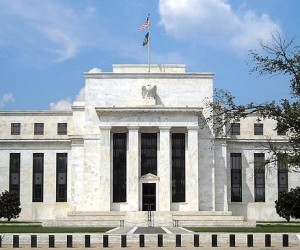IMF: The Risk Side of Exceptionally Low Interest Rates

US Federal Reserve
Several years of exceptionally low interest rates and bond buying by some advanced economy central banks have improved some indicators of banks’ health while supporting the economy and financial stability, according to new research from the International Monetary Fund.
In its latest Global Financial Stability Report, the IMF analyzes the effects of central bank policies on banks and financial stability since the global crisis. Central banks have taken bold policy actions that have reduced banking sector vulnerabilities and stabilized some markets, such as the interbank and mortgage securities markets. But the policies may have undesirable side-effects that could put financial stability at risk the longer they are in place.
The IMF said so far these risks are not showing up much in banks, but could be shifting to other parts of the financial sector, such as to so-called “shadow banks.” There is also some concern that the prolonged period of low interest rates is encouraging banks to roll over nonperforming loans rather than repairing their balance sheets.
“The policies may have undesirable side-effects that could put financial stability at risk the longer they are in place.”
“So far, so good, but if the time that central banks have provided through their unconventional policies is not used productively by financial institutions and their regulators, at some point we can expect another round of financial distress,” said Laura Kodres, chief of global stability analysis in the IMF’s Monetary and Capital Markets Department and the head of the team that produced the analysis.
Potential Risks
Despite the positive short-run effects for banks, there are financial risks associated with these central bank policies, which are likely to increase the longer they are maintained, according to the IMF.
The analysis found some aspects of this unprecedented monetary policy may be delaying balance sheet repair in banks and could raise credit risk over the medium term. This would explain the increase in market perceptions of bank default risk in response to central bank policy announcements, the IMF said.
Risks may also be shifting to other parts of the financial system not examined in the report, such as shadow banks, pension funds and insurance companies—or to other countries. Monitoring these risks requires improved data collection by those responsible for monitoring system-wide risks on nonbank financial institutions, as well as intrusive oversight by financial supervisors.
The report cautions that some risks may materialize when central banks end the measures taken in the wake of the global crisis.
Uncertainty about asset sales by central banks could lead to shifts in market sentiment and rapid price changes that could result in losses for bond holders—especially banks and central banks. The degree to which long-term yields may rise from their currently compressed levels, which would make bond prices drop, heightens this concern.
Losses could hurt weakly capitalized banks in the short run, although the IMF said the net effect of interest rate increases may be positive for banks over the medium term as their lending picks up.
Policymakers Should Be Vigilant and Flexible
“The report says that central bank policies should continue to support the economy and financial stability until the recovery is well established.”
The IMF said policymakers need to be vigilant and assess the emergence of potential and emerging financial stability threats. They also should use targeted policies designed to foster bank balance-sheet repair and reduce their vulnerability to market disruptions. By reducing the risks in the financial sector, micro- and macroprudential policies will allow greater leeway for monetary policy to support the economy.
The report identifies specific measures that could prove helpful to contain credit risk and funding challenges for banks, such as robust capital requirements, improved liquidity requirements, and well-designed dynamic forward-looking provisioning. Because the experience with some macroprudential tools is still relatively limited, the IMF recommends that policymakers closely monitor the effectiveness of their policies and stand ready to adjust them as needed. Coordination with other economic policies, such as monetary and fiscal policy, will also help reduce the reliance on macroprudential tools.
To minimize adverse effects on market sentiment, the IMF points out that it is important that central banks communicate clearly about their strategies to exit from their extraordinary policy measures, ahead of their implementation.
The IMF will publish more analysis from the Global Financial Stability Report on April 17.
You may have an interest in also reading…
Forbidden Pleasures: France Flouting EU Budget Rules
“A budget proposal written by poets and alchemists.” That’s how a visibly annoyed EU diplomat in Brussels described the 60-page
China Targets America’s Farms as Trump Tariffs Spur Retaliation
The Trump 2.0 administration is taking aim at China in its escalating tariff regime, but Beijing has responded with countermeasures
Ernst & Young, Argentina: The List from Black to White – Argentina Redefines Income Tax Law
Introduction To further our previous contribution – Tax Havens: The Argentine Government Issues a New Tax Regulation on Low or



















































































